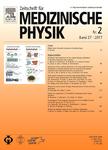版权所有:内蒙古大学图书馆 技术提供:维普资讯• 智图
内蒙古自治区呼和浩特市赛罕区大学西街235号 邮编: 010021

作者机构:Heidelberg Univ Univ Med Ctr Mannheim Dept Radiat Oncol Expt Radiat Oncol Heidelberg Germany Heidelberg Univ Interdisciplinary Ctr Sci Comp IWR Heidelberg Germany Cent Inst Mental Hlth ZI Mannheim Germany Heidelberg Univ Univ Med Ctr Mannheim Med Fac Mannheim Med Radiat Phys Radiat ProtectDept Radiat Oncol Heidelberg Germany Heidelberg Univ Univ Med Ctr Mannheim Dept Clin Radiol & Nucl Med Heidelberg Germany Heidelberg Univ Univ Med Ctr Mannheim Dept Radiat Oncol Heidelberg Germany
出 版 物:《ZEITSCHRIFT FUR MEDIZINISCHE PHYSIK》 (医学物理学杂志)
年 卷 期:2019年第29卷第1期
页 面:5-15页
核心收录:
主 题:Treatment planning Blood flow simulation Smoothed particle hydrodynamics Vessel segmentation Constrained constructive optimization Y-90-PET
摘 要:For selective internal radiation therapy (SIRT) the calculation of the 3D distribution of spheres based on individual blood flow properties is still an open and relevant research question. The purpose of this work is to develop and analyze a new treatment planning method for SIRT to calculate the absorbed dose distribution. For this intention, flow dynamics of the SIRT-spheres inside the blood vessels was simulated. The challenge is treatment planning solely using high-resolution imaging data available before treatment. The resolution required to reliably predict the sphere distribution and hence the dose was investigated. For this purpose, arteries of the liver were segmented from a contrast-enhanced angiographic CT. Due to the limited resolution of the given CT smaller vessels were generated via a vessel model. A combined 1D/3D-flow simulation model was implemented to simulate the final 3D distribution of spheres and dose. Results were evaluated against experimental data from Y-90-PET. Analysis showed that the resolution of the vessels within the angiographic CT of about 0.5 mm should be improved to a limit of about 150 mu m to reach a reliable prediction.